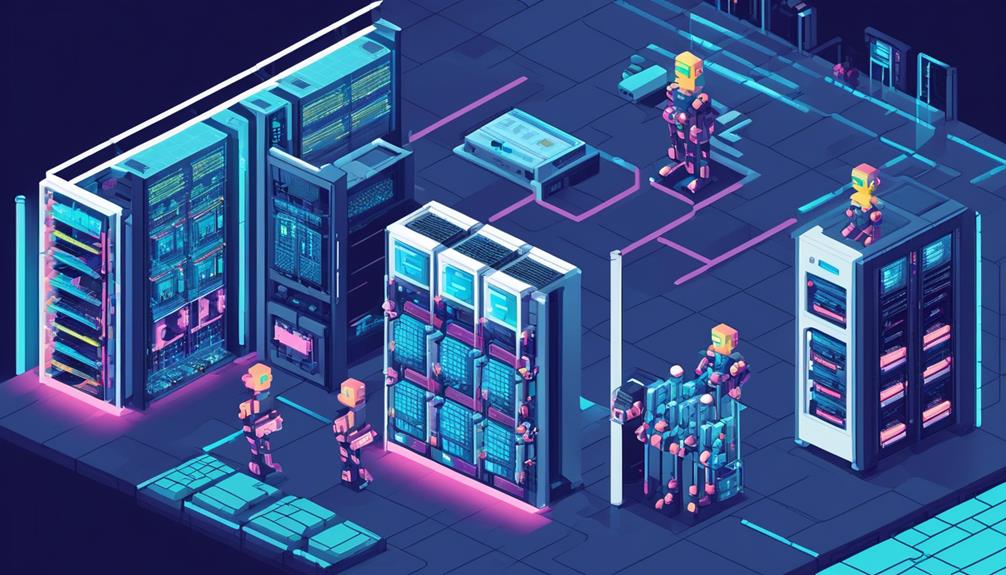As data centers continue to grow in size and complexity, the need for enhanced networking solutions becomes increasingly crucial. This is where the integration of Artificial Intelligence (AI) comes into play, offering a promising avenue for optimizing data center networking performance and efficiency.
By leveraging AI-driven technologies, such as predictive analytics and dynamic workload management, data centers can achieve significant improvements in energy consumption, resource utilization, and overall operational costs. Furthermore, AI-powered automation and data-driven decision-making enable streamlined processes and enhanced performance.
However, the true potential of AI for data center networking is yet to be fully explored, making it an intriguing and evolving field that holds great promise for the future.
Key Takeaways
- AI-driven data center networking optimizes performance, efficiency, and resource utilization.
- Ethernet and InfiniBand technologies are well-suited for AI data center networking.
- Scalable fabric architecture (SFA) and any-to-any non-blocking Clos fabric are recommended for AI model training and GPU scale.
- Proper flow control and congestion avoidance mechanisms are crucial for maximizing performance in AI data center networking.
AI-Driven Requirements for Data Center Networking
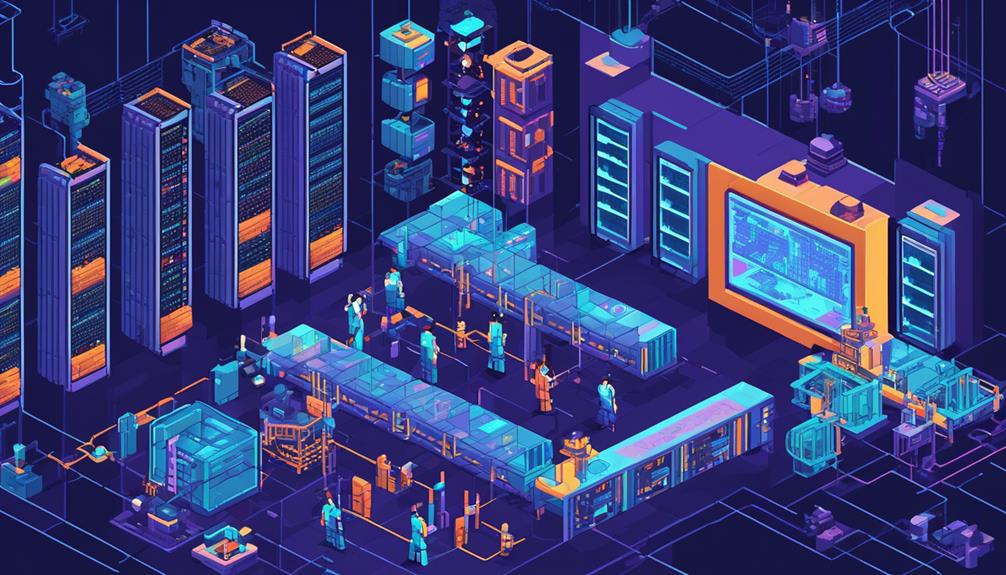
AI-driven requirements for data center networking involve various considerations, such as:
- Data preparation
- Extensive resource needs
- GPU suitability
- GPU server connections
- The importance of job completion time and minimizing tail latency.
High-performing networks are crucial for maximizing GPU utilization. Ethernet, with its congestion management capabilities and minimal latency, is well-suited for AI data center networking.
To meet the performance demands of AI processing, the recommended fabric design includes:
- Any-to-any non-blocking Clos fabric
- Ensuring consistent networking speed
- Optimizing based on model size and GPU scale.
Properly sized fabric interconnects play a crucial role in achieving efficient data transfer and minimizing bottlenecks.
Flow control and congestion avoidance are essential in AI data center networking. Techniques such as:
- Flow imbalance detection and correction
- Explicit Congestion Notification (ECN) with Data Center Quantized Congestion Notification (DCQCN)
- Dynamic load balancing
- Priority Flow Control (PFC)
These techniques are key to managing network traffic effectively.
InfiniBand technology is particularly crucial for large-scale supercomputing and AI factories due to its high bandwidth and low-latency characteristics. However, for AI infrastructure based on Ethernet networks, specific considerations and purpose-built technology like Spectrum-X are necessary to handle the demanding requirements of AI workloads.
Fabric Design for AI Data Center Networking
When designing a fabric for AI data center networking, scalability and intelligent network optimization are key considerations.
A scalable fabric architecture ensures that the network can handle the increasing demands of AI workloads, while intelligent network optimization maximizes the efficiency and performance of the system.
Scalable Fabric Architecture
Scalable Fabric Architecture (SFA) is a highly recommended solution for optimizing AI data center networking, providing unparalleled scalability, non-blocking interconnectivity, and high-speed performance for AI workloads. Different fabric designs, such as any-to-any non-blocking Clos fabric, are tailored to optimize AI model training and GPU scale. To ensure efficient operation, flow control and congestion avoidance mechanisms are essential for optimizing SFA in AI data center networking. Proper fabric interconnect sizing, congestion detection, and adaptive load balancing techniques are crucial for maximizing SFA performance.
To illustrate the benefits of SFA, consider the following table:
| Key Features | Benefits |
|---|---|
| Unparalleled Scalability | Allows for the seamless expansion of AI systems in data centers, accommodating growing workloads. |
| Non-blocking Interconnectivity | Ensures that all AI workloads can communicate simultaneously without any performance degradation. |
| High-speed Performance | Facilitates fast data transfer, minimizing latency and enabling real-time processing of AI tasks. |
| Optimal AI Workload Optimization | SFA fabric designs are specifically tailored to maximize the efficiency of AI model training. |
Intelligent Network Optimization
To optimize AI data center networking, fabric design plays a crucial role in intelligent network optimization. This includes recommended fabric design of any-to-any non-blocking Clos fabric with consistent networking speed of 400 Gbps (moving to 800 Gbps) and dynamic load balancing for optimal performance.
Flow control and congestion avoidance strategies are also crucial for efficient AI data center networking. These strategies include properly sized fabric interconnects, ECN with DCQCN, and priority-based flow control.
InfiniBand technology is essential for large-scale supercomputing and AI factories. It offers ultra-low latencies and an efficient congestion control architecture.
Ethernet networks for AI infrastructure require purpose-built technologies such as NVIDIA Spectrum-X with RDMA over Converged Ethernet (RoCE) Extensions. These technologies address specific performance needs and isolation requirements.
Flow Control and Congestion Avoidance in AI Networking
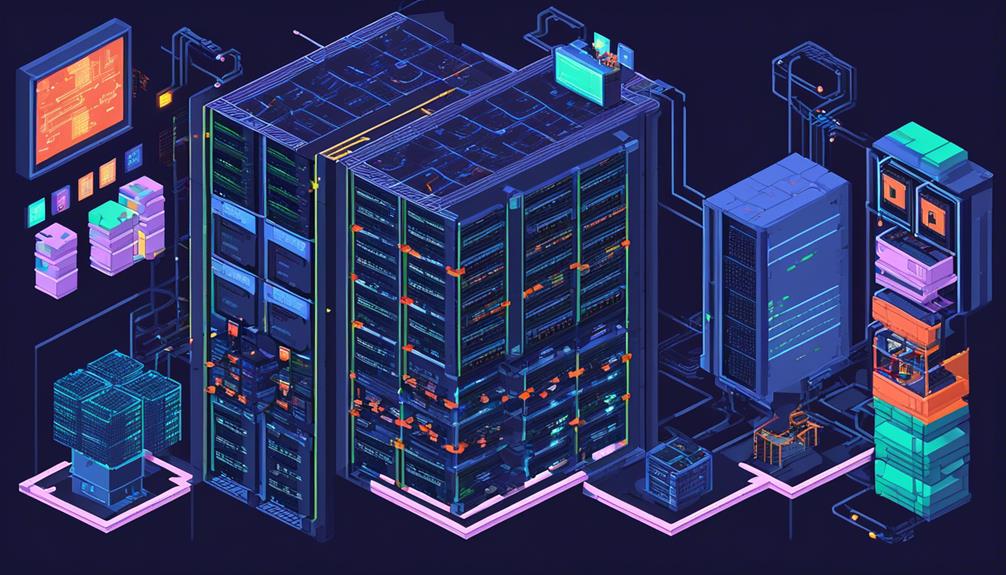
Flow control and congestion avoidance are critical aspects of AI networking that directly impact network performance optimization.
Properly sized fabric interconnects and optimal links are essential for managing flow imbalances and preventing congestion.
Techniques such as Explicit Congestion Notification (ECN) with DCQCN, dynamic load balancing, and priority-based flow control (PFC) play key roles in achieving lossless transmission and efficient congestion avoidance in AI networking.
AI Flow Control
How can AI Flow Control enhance the efficiency of network traffic for AI workloads in data center networking? AI Flow Control plays a crucial role in optimizing network traffic for AI workloads in data centers. By detecting and correcting flow imbalances, AI Flow Control helps avoid congestion and ensures efficient data processing for AI models. Techniques such as Explicit Congestion Notification (ECN) with DCQCN are employed to resolve flow imbalances and reduce congestion. Additionally, priority-based flow control (PFC) enables lossless transmission, contributing to effective flow control in AI data center networking. Properly sized fabric interconnects with optimal links are essential for efficient flow control and congestion avoidance in AI networking environments. By implementing AI Flow Control, data centers can improve job completion time and enhance the overall performance of AI and machine learning systems.
| AI Flow Control Benefits | Description |
|---|---|
| Efficient data processing | AI Flow Control optimizes network traffic, enabling efficient data processing for AI workloads in data centers. |
| Congestion avoidance | By detecting and correcting flow imbalances, AI Flow Control helps avoid congestion in AI networking environments. |
| Improved job completion time | Implementing AI Flow Control improves job completion time, enhancing the performance of AI and machine learning systems in data center environments. |
| Lossless transmission | Priority-based flow control (PFC) enables lossless transmission, ensuring the reliable transfer of data in AI data center networking. |
| Enhanced network performance | AI Flow Control, along with proper network design, improves the overall performance of data centers by optimizing network traffic for AI workloads, leading to better productivity and resource utilization.
Congestion Avoidance Techniques
Congestion avoidance techniques play a crucial role in ensuring optimal performance and efficient network traffic management for AI workloads in data center networking.
To achieve this, several techniques are employed:
- Properly sized fabric interconnects with optimal links: These components are essential in preventing congestion and maintaining smooth data flow within the network.
- Flow imbalances detection and correction: By identifying and resolving flow imbalances, congestion can be avoided, leading to improved AI performance and reduced job completion time.
- Explicit Congestion Notification (ECN) with DCQCN: This technique utilizes quantized congestion notification to address flow imbalances and prevent congestion effectively.
- Dynamic and adaptive load balancing: By dynamically distributing the network traffic, congestion can be mitigated, resulting in improved AI performance and reduced power usage.
Implementing these congestion avoidance techniques in data center networking is crucial for enhancing AI performance, ensuring efficient resource utilization, and minimizing job completion time.
Network Performance Optimization
To optimize network performance in AI data center networking, the effective implementation of flow control and congestion avoidance mechanisms is crucial. Properly sized fabric interconnects and optimal links play a significant role in ensuring smooth data flow. Flow imbalances can lead to congestion, affecting job completion time and overall network performance. To address this, explicit congestion notification (ECN) with DCQCN and dynamic load balancing are utilized to detect and correct flow imbalances. Priority-based flow control (PFC) ensures lossless transmission, while adaptive load balancing helps reduce congestion. AI-driven congestion avoidance strategies are employed to optimize job completion time by managing flow and minimizing latency. By implementing these mechanisms, data centers can maximize network performance and enhance overall data center operations.
| Mechanism | Description | Benefits |
|---|---|---|
| Flow Control | Manages data flow to avoid congestion and ensure smooth transmission. | Prevents packet loss and maintains network stability. |
| Congestion Avoidance | Detects and corrects flow imbalances to prevent congestion. | Reduces job completion time and optimizes network performance. |
| AI-driven Strategies | Utilizes machine learning algorithms to dynamically manage flow and minimize latency. | Improves overall network efficiency and enhances data center operations. |
Scale and Performance in AI Data Center Networking

Scalability and performance are crucial factors in enhancing the efficiency of AI data center networking, as they enable the effective handling of extensive data and compute resources required for AI training.
To achieve optimal performance and scale in AI data center networking, several key considerations must be taken into account:
- Connection of multiple GPU servers: The ability to connect and utilize multiple GPU servers is essential for achieving high-performance AI data center networking. By leveraging the computational power of multiple GPUs, organizations can accelerate the training process for machine learning models and reduce job completion time.
- Fabric design: The design of the networking fabric plays a significant role in enhancing scale and performance in AI data centers. Fabric architectures such as any-to-any non-blocking Clos fabric provide the necessary connectivity and bandwidth to support the massive data flows associated with AI workloads. Proper flow control and congestion avoidance mechanisms, such as quantized congestion notification, are also critical to ensuring smooth data transmission and avoiding bottlenecks.
- High-performance networking technologies: To achieve optimal performance in AI data center networking, technologies with ultra-low latencies and high bandwidth capabilities are vital. InfiniBand technology and Ethernet networks with RDMA over Converged Ethernet (RoCE) Extensions offer the required performance levels, enabling fast and efficient data transfers between compute and storage resources.
- Juniper's AI Data Center solution: Juniper offers an AI Data Center solution that provides interoperability, design flexibility, and reliability to support the scale and performance requirements of AI data center networking. By leveraging Juniper's networking software and hardware solutions, organizations can optimize their AI infrastructure and ensure seamless integration with high-performance computing environments.
Automation for Enhanced Data Center Networking
Automation plays a crucial role in enhancing data center networking. It streamlines network management and improves network efficiency. Tasks such as provisioning, configuration, and monitoring can be automated, reducing human error and improving operational efficiency. Automation also enables dynamic resource allocation and load balancing, optimizing network performance. This is particularly important for AI and machine learning workloads, as it ensures low latency. By leveraging automation, data centers can achieve higher scalability, better performance, and more efficient utilization of network resources.
Streamlined Network Management
Efficient and reliable data center networking processes are achieved through the implementation of streamlined network management automation. By leveraging AI and machine learning technologies, data centers can optimize their networking infrastructure for high performance and resource optimization.
Here are four key benefits of streamlined network management:
- Reduced manual intervention and human error: Automation minimizes the need for manual configuration and monitoring, reducing the risk of human errors in network management tasks.
- Enhanced agility and responsiveness: Streamlined network management allows data centers to quickly adapt to changing network demands, ensuring efficient resource allocation and utilization.
- Congestion management: Automation enables real-time monitoring and congestion detection, allowing for proactive measures to prevent network congestion and ensure smooth operations.
- Simplified provisioning and troubleshooting: Automated network management streamlines the provisioning, configuration, monitoring, and troubleshooting processes, improving overall efficiency and reducing downtime.
Improved Network Efficiency
Improved network efficiency in data centers can be achieved through the implementation of advanced automation techniques and AI-driven optimization strategies. By leveraging artificial intelligence and machine learning, data centers can significantly enhance their network performance and reduce job completion time. AI applications can optimize network traffic by analyzing patterns and making real-time adjustments to ensure smooth data flow with minimal latency. In addition, quantized congestion notification and intelligent flow control mechanisms can be employed to prevent bottlenecks and improve overall network efficiency. The table below highlights the key factors that contribute to improved network efficiency in data centers:
| Factors | Description |
|---|---|
| Fabric Design | Proper design of network fabric for efficient data flow |
| Flow Control | Intelligent control of data flow to prevent congestion |
| AI-driven Resource Management | AI-based optimization of resource allocation for improved performance |
| Security Measures | Implementation of advanced security measures for data protection |
| Job Completion Time | Reduction of job completion time through AI optimization |
Juniper's AI Data Center Networking Solution
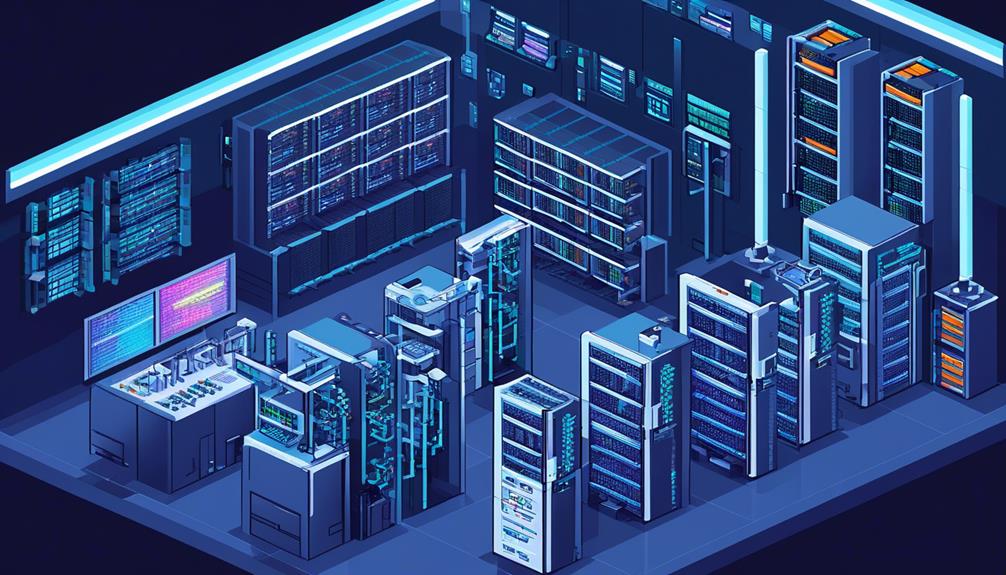
Juniper's AI Data Center Networking Solution enables rigorous network scalability, performance, and low latency for AI and machine learning workloads by leveraging open Ethernet technology and integrating industry-leading AIOps and networking technologies. This solution caters to the specific requirements of AI and machine learning applications, which demand high-performance computing and efficient data transfer.
Here are the key features and benefits of Juniper's AI Data Center Networking Solution:
- Enhanced Job Completion Time (JCT): The solution optimizes job completion time by providing congestion management and load balancing capabilities. It ensures efficient data transfer, minimizing tail latency and improving overall system performance.
- Quantized Congestion Notification (QCN): Juniper's solution incorporates QCN, which enables real-time monitoring and control of network congestion. This feature enhances network efficiency and reduces packet loss, ensuring smooth data flow for AI and machine learning workloads.
- Maximizing GPU Utilization: The solution is designed to maximize GPU utilization by minimizing network-related bottlenecks. By optimizing data transfer and reducing latency, Juniper's solution ensures that GPUs are fully utilized, leading to faster processing of AI and machine learning tasks.
- Cost Savings and Deployment Acceleration: With up to 90% lower networking-related OPEX and an operations-first approach, Juniper's solution offers cost savings and accelerates deployment through intent-based automation. It provides a flexible and interoperable solution that works seamlessly with leading GPUs, fabrics, and switches, avoiding vendor lock-in and maximizing design flexibility.
Juniper's AI Data Center Networking Solution is a comprehensive offering tailored to meet the demanding requirements of AI and machine learning workloads in data centers. By leveraging advanced technologies and providing efficient data transfer, this solution enables organizations to achieve higher performance, faster job completion times, and improved overall efficiency in their AI and machine learning initiatives.
AI Data Center Networking and Problem Solving
AI Data Center Networking and Problem Solving involve addressing the specific challenges and requirements of AI and machine learning workloads in data centers, such as rigorous scalability, low latency, and efficient utilization of resources. To enhance data center networking for AI, several considerations must be made.
One key requirement for AI data center networking is the availability of extensive data and compute resources. AI workloads often involve large datasets that require high-performance storage systems. Moreover, GPUs play a crucial role in AI learning and inference workloads, necessitating the need for GPU support in data centers.
Efficient utilization of resources is also critical in AI data center networking. Optimization of job completion time (JCT) and tail latency is essential to ensure timely processing of AI workloads. Companies like Adobe Systems Incorporated are leveraging AI-powered networking solutions to reduce JCT by up to 40%.
To achieve low latency and high throughput, AI data centers employ advanced congestion control mechanisms. Quantized Congestion Notification (DCQCN) is a popular technique that enables congestion control at a fine granularity, ensuring smooth data flow in the network.
In terms of network architecture, AI data center networking benefits from an any-to-any non-blocking Clos fabric design. This design allows for efficient communication between compute and storage resources, boosting overall system performance. Additionally, Ethernet is often preferred as an open technology for AI data center networking due to its scalability and compatibility with existing infrastructure.
In summary, AI Data Center Networking and Problem Solving address the unique challenges posed by AI and machine learning workloads. By optimizing resource utilization, implementing advanced congestion control mechanisms, and adopting suitable network architectures, data centers can effectively support the demands of artificial intelligence.
| Key Considerations | AI Data Center Networking |
|---|---|
| Resource Utilization | Efficient utilization of compute and storage resources |
| Latency Optimization | Minimizing job completion time (JCT) and tail latency |
| Congestion Control | Implementing techniques like Quantized Congestion Notification (DCQCN) |
| Network Architecture | Any-to-any non-blocking Clos fabric design with Ethernet technology |
Advantages of Ethernet for AI Networking
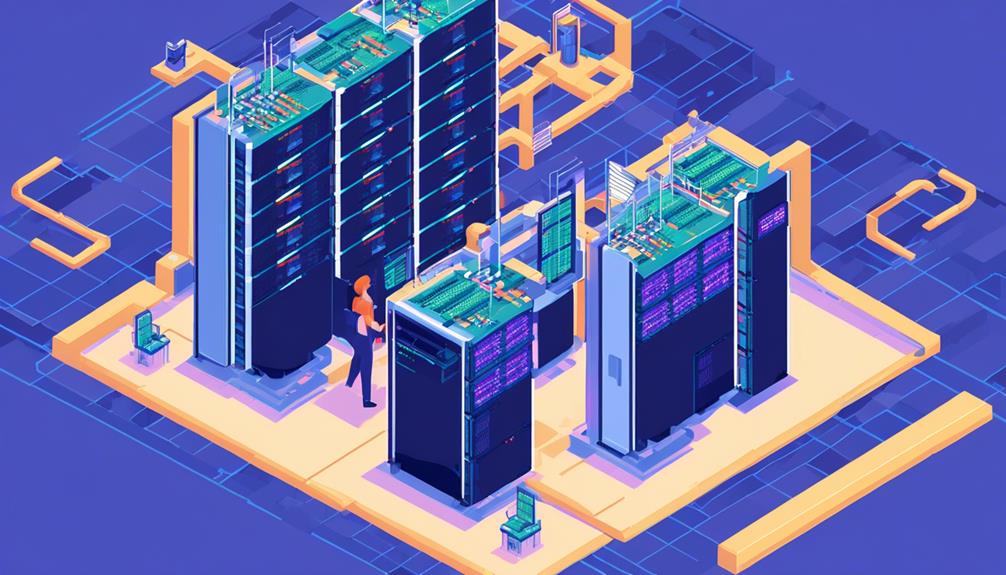
Ethernet technology offers significant advantages for AI networking due to its operational and cost benefits, rigorous scalability, and low latency performance.
In the context of data centers and machine learning systems, Ethernet proves to be a valuable resource for enhancing AI capabilities. Here are the advantages of Ethernet for AI networking:
- Operational and cost benefits: Ethernet adoption is driven by its ability to support extensive data and compute resources required for AI training. Its operational efficiency and cost-effectiveness make it an attractive option for data centers looking to incorporate AI into their infrastructure.
- Rigorous scalability: AI workloads often require massive amounts of data processing and storage. Ethernet's rigorous scalability allows data centers to scale their networking capabilities seamlessly, ensuring that the growing demands of AI systems can be met without disruption.
- Low latency performance: AI applications heavily rely on real-time data processing and analysis. Ethernet's low latency performance enables faster communication between AI systems, resulting in quicker decision-making and improved overall performance.
- Enhancing resource utilization: High-performing Ethernet networks maximize GPU utilization in AI data centers. By efficiently distributing workloads across GPUs, Ethernet helps to optimize resource utilization and improve the efficiency of AI training processes.
In addition to these advantages, Ethernet's open technology and enhancements like congestion management and load balancing make it well-suited for AI data center networking. As AI continues to revolutionize various industries, the use of Ethernet in data centers will play a vital role in supporting and enabling the development of advanced AI systems.
AI Solutions by Juniper for Data Center Networking
With its advanced AI solutions, Juniper offers a comprehensive range of data center networking capabilities to support the rigorous scalability, performance, and low latency requirements of AI and machine learning workloads. Juniper's AI solutions provide several benefits for data center networking, including lower networking-related operational expenses (OPEX), simplified network complexity, and accelerated deployment.
Juniper's AI solutions are designed to optimize job completion time and minimize tail latency, both of which are crucial in AI data center networking. By maximizing GPU utilization through high-performing networks, Juniper ensures efficient AI model development and inference.
To illustrate Juniper's AI solutions for data center networking, the following table provides an overview of the key features and benefits:
| Features | Benefits |
|---|---|
| Lower networking-related OPEX | Up to 90% reduction in operational expenses |
| Simplified network complexity | Easier management and troubleshooting |
| Accelerated deployment | Quick and efficient implementation |
| Interoperability with leading GPUs, fabrics, and switches | Design flexibility and compatibility |
| Optimization for job completion time | Improved efficiency and productivity |
| Minimized tail latency | Enhanced responsiveness and performance |
Intent-Based Networking and AI

Intent-Based Networking (IBN) combined with AI-enabled network automation offers numerous benefits for data center networking.
With IBN, businesses can translate their intent into network policies and configurations, ensuring enhanced network reliability and agility.
AI-driven automation further improves operational efficiency and security by enabling predictive analytics, anomaly detection, and automated network optimization.
Benefits of Intent-Based Networking
The implementation of Intent-Based Networking (IBN) in data center networking brings numerous benefits. These benefits include enhancing network configuration automation, security enforcement, troubleshooting efficiency, performance, and scalability.
- Automated network configuration: IBN allows network administrators to define business intent, enabling the network to automatically adapt and meet those requirements. This reduces human errors and improves network agility.
- Enhanced security: IBN enforces network policies and compliance, reducing the risk of unauthorized access or security breaches.
- Efficient troubleshooting: IBN automates network troubleshooting, leading to faster problem resolution and reduced operational costs.
- Improved performance and scalability: IBN enables better network performance and scalability. This allows for smoother network operations and accommodates business growth and changing requirements.
AI-enabled Network Automation
AI-enabled network automation, including the integration of Intent-Based Networking and AI, revolutionizes data center networking by enabling intelligent decision-making and automation.
This approach streamlines network management through intelligent automation and leverages AI to interpret high-level business objectives and translate them into network policies, automating the configuration and optimization of network resources.
With AI capabilities, network automation can provide predictive and prescriptive insights, allowing the network to adapt and self-optimize in real-time based on changing conditions and performance requirements.
Furthermore, AI-driven network automation enhances security by continuously monitoring for anomalies, identifying potential threats, and autonomously responding to security incidents.
Enhancing Network Security
Network security is greatly enhanced through the integration of Intent-Based Networking and AI, revolutionizing the way data centers protect their networks from potential threats and vulnerabilities.
Here are four ways in which AI enhances network security in data centers:
- Intent-Based Networking (IBN) utilizes AI to automate network security policies and configurations based on business intent, ensuring consistent and proactive security measures.
- AI-driven security systems continuously analyze network traffic, enabling real-time threat detection and immediate response to potential security breaches.
- AI-based anomaly detection and behavioral analytics enhance network security by identifying and mitigating abnormal activities or unauthorized access attempts.
- Intent-Based Networking leverages AI to dynamically adapt security measures based on changing network conditions and threat landscapes, ensuring adaptive and resilient security defenses.
With AI-driven network security solutions, data center operators can proactively manage risks, preempt potential vulnerabilities, and safeguard critical data and infrastructure.
Artificial Intelligence for Networking

Artificial intelligence plays a crucial role in enhancing networking capabilities within data centers. AI enables efficient and effective data flow control, ensuring optimal performance for AI and machine learning workloads. Data center operators are increasingly recognizing the benefits of using AI to overcome the limitations of traditional data center networking.
AI continues to revolutionize data centers by providing scalable and high-performing networks. AI-powered data center networking supports the rigorous requirements of AI model development, which involves data preparation, training, and inference. These processes demand extensive data and compute resources, often leveraging GPUs. By maximizing GPU utilization, AI data center networking enables rigorous scalability, high performance, and low latency for AI workloads.
Ethernet has emerged as an open technology well-suited for AI networking. It enables enhancements for congestion management and load balancing, ensuring optimal network performance. To achieve this, fabric design for AI data center networking recommends the use of any-to-any non-blocking Clos fabric. This design ensures consistent networking speeds of 400 Gbps, optimizing network performance based on the size of the AI model and GPU scale.
Flow control and congestion avoidance are critical aspects of AI data center networking. Properly sized fabric interconnects, along with the detection and correction of flow imbalances, are essential for efficient data flow. AI data center networking utilizes explicit congestion notification (ECN) and dynamic load balancing to manage congestion and ensure smooth data flow.
Understanding AIOps in Data Center Networking
AIOps, or Artificial Intelligence for IT Operations, plays a crucial role in optimizing data center networking capabilities. With the increasing demand for seamless and highly scalable data center networks, AIOps leverages AI and machine learning workloads to enable rigorous network scalability, performance, and low latency.
To understand AIOps in data center networking, consider the following key points:
- AIOps in data center networking supports AI and machine learning workloads, providing the necessary resources for AI training and inference.
- Networking technologies like InfiniBand and Ethernet are commonly used for AIOps in data centers. Ethernet adoption is driven by its operational and cost advantages, making it the dominant choice in the market.
- AIOps in data center networking requires extensive data and compute resources to meet the AI-driven requirements. These resources are specifically designed to handle the processing units required for AI tasks.
- Flow control is an essential aspect of AIOps in data center networking. It ensures efficient data transmission and prevents congestion in the network, allowing for smooth operations and optimal performance.
By leveraging AIOps, data centers can enhance their networking capabilities and meet the increasing demands of AI-driven workloads. The seamless integration of AI technologies into data center networking enables scalability, performance, and low latency, making it an essential component in the modern data center infrastructure.
Please note that the use of this output, including the bullet list, is subject to OpenAI's GPT-3 model's prior written permission policy.
Impact of AI on Data Center Operations
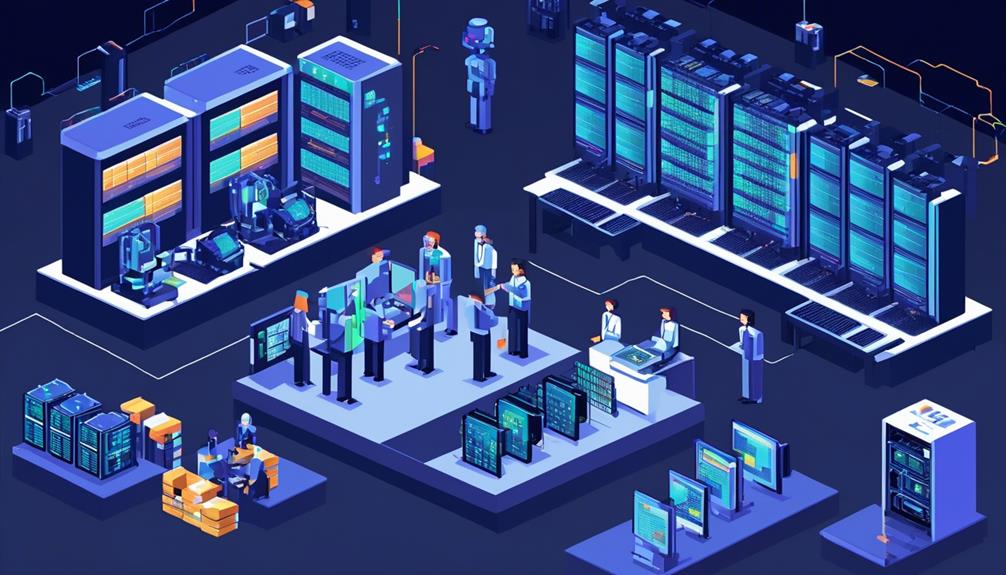
With the increasing integration of AI technologies into data center networking, the impact of AI on data center operations is becoming increasingly evident. AI and machine learning algorithms are revolutionizing the way data centers operate by optimizing various aspects of their operations. Let's explore the impact of AI on data center operations in more detail.
The following table highlights some key areas where AI is enhancing data center operations:
| Impact of AI on Data Center Operations | Description |
|---|---|
| Optimization of Cooling Systems | AI algorithms analyze temperature data and adjust cooling systems to maintain optimal conditions, reducing energy consumption and costs. |
| Efficient Resource Management | AI optimizes the allocation of hardware and network services, ensuring efficient utilization and enabling dynamic workload management. Predictive maintenance helps prevent hardware failures and downtime. |
| Enhanced Security Measures | AI helps detect anomalies and potential security threats by analyzing network traffic, enabling proactive security measures to protect against evolving cyber threats. |
| Cost Reduction and Energy Efficiency | AI optimizes power allocation and rack space utilization, leading to cost reduction and improved energy efficiency in data centers. |
By leveraging AI, data centers can streamline their operations, lower costs, and improve overall efficiency. AI-powered systems can automate routine tasks, identify patterns, and provide valuable insights that enable data center operators to make informed decisions.
Furthermore, as data centers continue to evolve, advanced AI technologies, quantum computing, and emerging technologies will shape the future of data center operations. These advancements will ensure ethical and efficient responses to changing demands, further enhancing the capabilities of data center networking.
AI in Data Centers: Future and Recap
The future of data centers lies in the integration and advancement of AI technologies. AI in data centers holds immense potential for enhancing network performance, scalability, and latency requirements.
Here are some key insights into the future of AI in data centers:
- Improved Network Performance: AI-powered data centers can leverage advanced algorithms to optimize network traffic and improve overall performance. By analyzing data flows and identifying bottlenecks, AI can dynamically adjust network configurations to ensure efficient data transmission.
- Enhanced Security: With the increasing complexity of data center networks, AI can play a crucial role in identifying and mitigating security threats. AI algorithms can monitor network traffic patterns, detect anomalies, and provide real-time alerts for potential security breaches, helping data centers safeguard valuable information.
- Optimized Resource Allocation: AI can assist data centers in efficiently allocating resources based on workload demands. By analyzing historical data and predicting future requirements, AI algorithms can dynamically allocate compute, storage, and network resources to optimize performance and reduce operational costs.
- Predictive Maintenance: AI-powered data centers can proactively monitor and predict hardware failures, allowing for timely maintenance and minimizing downtime. By analyzing sensor data and historical patterns, AI algorithms can detect early warning signs of equipment failure, enabling data centers to take preventive measures and ensure uninterrupted operations.
Frequently Asked Questions
How Is AI Used in Data Centers?
AI is used in data centers for a variety of purposes. It powers network optimization through AI-based algorithms and machine learning techniques.
It enables anomaly detection in data centers by leveraging AI-driven approaches.
Automated network configuration using AI helps streamline operations.
Real-time network monitoring is achieved through AI-enabled solutions.
Predictive maintenance in data centers is improved with AI-based predictive models.
Deep learning is employed for traffic analysis in networking.
AI also plays a key role in network security and threat detection, providing advanced capabilities for identifying and mitigating risks.
How AI Can Be Used in Networking?
AI can be used in networking through various applications such as:
- AI-driven network optimization
- Intelligent traffic analysis
- Predictive network maintenance
- AI-assisted network security
- Automated network troubleshooting
- AI-powered network capacity planning
- Machine learning in network performance monitoring
- AI-enabled network anomaly detection
These technologies leverage AI and machine learning algorithms to enhance data center networking by:
- Optimizing network performance
- Analyzing network traffic
- Predicting and preventing network failures
- Securing network infrastructure
- Automating network management tasks
- Improving network capacity planning and anomaly detection capabilities.
What Is the Application of AI in Network Infrastructure?
AI has a wide range of applications in network infrastructure. Some examples of these applications include:
- AI-powered network optimization
- AI-driven network security
- AI-based network anomaly detection
- AI-driven network traffic prediction
- AI-enabled network fault diagnosis
- AI-assisted network performance monitoring
- AI-powered network capacity planning
- AI-driven network automation
These applications leverage AI algorithms and machine learning techniques to enhance network efficiency, reliability, and security. By analyzing network data and patterns, AI can identify and mitigate issues, predict network traffic, automate network management tasks, and improve overall network performance and capacity planning.
What Is Generative AI in Networking?
Generative AI in networking refers to the use of AI systems to create new data based on learned patterns. It offers several benefits, including the ability to generate synthetic data for training AI models, optimize network traffic patterns, and improve network performance.
Implementing generative AI in networking, however, poses challenges such as data quality and security. The future prospects of generative AI in networking include automating network configurations and dynamically adapting to changing conditions.
Machine learning plays a crucial role in enabling generative AI for networking. It has the potential to significantly impact network performance by introducing intelligent and adaptive capabilities.
Ethical considerations must also be taken into account when using generative AI in networking. Comparing generative AI with traditional networking approaches highlights its potential to revolutionize network design, traffic management, and security.
